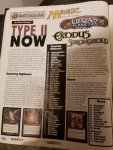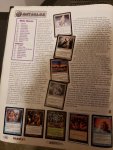Oversoul
The Tentacled One
Jumping back to the history of Academy itself for a bit, the card had been restricted in Type 1 to stop the dominance of the Academy deck, but combo decks with only one copy of Academy, commonly known as "Neo-Academy" were still possible. Type 1 records from back then are deplorably sparse, and I truly do not know how strong Neo-Academy was relative to the competition in 1999. Perhaps it was dominant. Well, this led to sweeping changes to Type 1 in September...
Shahrazad and Divine Intervention were unbanned. Both had been banned based on the philosophy that they would be detrimental to competitive play if they hypothetically could be exploited, although neither demonstrated much potential for exploitability.
Ivory Tower, Mirror Universe, and Underworld Dream were unrestricted. Those restrictions were historical relics from the original constructed tournament format in 1994, and by 1999 the DCI had gained a better handle on how tournament decks played. Ivory Tower had been restricted out of an archaic fear that efficient recurring lifegain would draw games out to extreme lengths and ruin tournaments. The other two had been reflexively restricted to quell ancient combo decks.
But the big change came in the form of restrictions. A whopping eighteen cards were added to the restricted list. 18 cards. Perhaps Standard and Extended contributed more to the reputation of the Urza's Block sets as broken, but I remember the waves of Type 1 restrictions being considered a big deal at the time because Type 1 was the format where anything could happen, where the restricted cards had previously been old and broken stuff like the Power 9. But there are some real issues with this wave of restrictions, so I'd better actually list the cards, then point out some details. These were the eighteen cards simultaneously restricted in September of 1999...
Crop Rotation
Doomsday
Dream Halls
Enlightened Tutor
Frantic Search
Grim Monolith
Hurkyl's Recall
Lotus Petal
Mana Crypt
Mana Vault
Mind Over Matter
Mox Diamond
Mystical Tutor
Tinker
Vampiric Tutor
Voltaic Key
Yawgmoth's Bargain
Yawgmoth's Will
Now then, I'll note some points about these cards, which might range from obvious to slightly esoteric...
Shahrazad and Divine Intervention were unbanned. Both had been banned based on the philosophy that they would be detrimental to competitive play if they hypothetically could be exploited, although neither demonstrated much potential for exploitability.
Ivory Tower, Mirror Universe, and Underworld Dream were unrestricted. Those restrictions were historical relics from the original constructed tournament format in 1994, and by 1999 the DCI had gained a better handle on how tournament decks played. Ivory Tower had been restricted out of an archaic fear that efficient recurring lifegain would draw games out to extreme lengths and ruin tournaments. The other two had been reflexively restricted to quell ancient combo decks.
But the big change came in the form of restrictions. A whopping eighteen cards were added to the restricted list. 18 cards. Perhaps Standard and Extended contributed more to the reputation of the Urza's Block sets as broken, but I remember the waves of Type 1 restrictions being considered a big deal at the time because Type 1 was the format where anything could happen, where the restricted cards had previously been old and broken stuff like the Power 9. But there are some real issues with this wave of restrictions, so I'd better actually list the cards, then point out some details. These were the eighteen cards simultaneously restricted in September of 1999...
Crop Rotation
Doomsday
Dream Halls
Enlightened Tutor
Frantic Search
Grim Monolith
Hurkyl's Recall
Lotus Petal
Mana Crypt
Mana Vault
Mind Over Matter
Mox Diamond
Mystical Tutor
Tinker
Vampiric Tutor
Voltaic Key
Yawgmoth's Bargain
Yawgmoth's Will
Now then, I'll note some points about these cards, which might range from obvious to slightly esoteric...
- Only 7 out of the 18 were actually printed in Urza's Block sets. The other 11 cards (what I'd call most of them), were older.
- Of the 7 Urza's Block cards restricted in this wave, only 2 of them remain on the restricted list today: Tinker and Yawgmoth's Will.
- While separating cards targeted for specific archetypes from cards with more general utility is subjective, about half of this list was restricted to target the Neo-Academy deck. The other half were restricted to nerf what were, at that time, fringe combo decks (or nonexistent combo decks that it was feared would emerge in place of Neo-Academy).
- Of the 11 older cards that were restricted in this wave, 6 of them were later taken off the list. The 5 that remain restricted are Vampiric Tutor, Mystical Tutor, and 3 mana-producing artifacts.
- Even acknowledging that I'm looking at this stuff with 19 years of hindsight, it strikes me as abjectly silly that up to this point, players could use playsets of Mana Crypt in tournaments. Like, it's a complex game and there's a learning curve. Players and WotC needed time to learn that Vampiric Tutor really is too strong a tutor to leave unrestricted, because it wasn't directly comparable to Demonic Tutor and it takes some actual experience with the card to go, "Hey, this is still too strong." But Mana Crypt?



